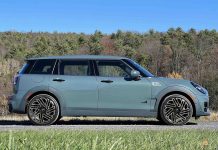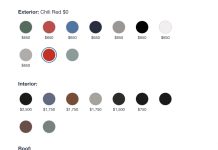Less than three years from now, there could easily be three fewer car companies left on the field. One is the victim of a bad marriage, the other a victim of Uncle and the last a victim of its own bad decisions. In no particular order, they are:
*Mitsubishi –
The other day, the company posted a withering 81 percent loss, reflecting at least three years of flat-lined sales caused chiefly by a dead-in-the-water model lineup, the result of the company not having the money to invest much in new models.
This circling of the drain was triggered by a disastrous decision several years back to give away cars as a way to jump start sales. You may remember the “zero down, zero interest and zero payments for a year” thing. Wait. You are offering to let me drive off the lot in a brand-new car, without me giving you anything in return except a hearty handshake and my promise to pay you sometime next year?
Yes, indeed!
Lots of people took Mitsu up on their free ride offer. And took Mitsu for a ride. They drove their year-long free loaner like a teenager who got his hands on Dad’s Corvette. Then shrugged at the end of the year, said they couldn’t afford to pay – and let Mitsu have the remains back. This cost Mitsu a great deal of money and not only directly. It cratered the resale values of Mitsubishi vehicles generally as vast fleets of thoroughly trashed, year-old cars hit the back lots of the dealerships.
Now Mitsubishi had to give them away again.
It hasn’t helped that Mitsubishi’s overall track record for reliability isn’t the greatest – and it really hasn’t helped that the company just got busted for fudging the mileage numbers it touted for its cars. Unlike what VW got caught doing (hang on) this actually did hurt the people who bought the cars, as opposed to affronting government bureaucrats.
The sad thing about all this is that Mitsu currently sells what may be the smartest little car Uncle will let anyone buy – the Mirage. Just updated (one of two Mitsubishi vehicles that’s not as dated as parachute pants) this virtually unknown (because Mitsu has no money to advertise it) subcompact is cheap – $12,995 – and gets 40-plus MPG on the highway. It has a not-turbocharged three cylinder engine, so it has simple, probably long-haul-reliable mechanicals. As an A to B transportation appliance, it makes a lot of sense. More sense than a $24,000 Prius .
But if you’re interested, better hurry.
A year ago, VW was Autobahn cruising at 140-plus, one of the most successful brands in the world – not just the United States. One year hence and VW is in serious trouble as a result not so much of having “cheated” Uncle and getting caught doing so – but because the company did a Greaseman-style writhing on the floor mea culpa. Apologizing for its sins, like the once-famous radio shock jock did all those years ago. Some of you may remember – and recall what became of the Greaseman.
The same kind of fate may befall VW.
It would have been a lot less expensive – and far more dignified – to fight Uncle. And, much more important, explain to the public what it did and why. That – yes – it “cheated” federal exhaust emissions tests by programming the cars so that when tested, their exhaust was within the parameters set forth by the increasingly demented EPA’s standards but on occasion, slightly higher out in the real world. Slightly as in fractionally (less than 1 percent, literally) higher out in the real world, under certain conditions, such as wide-open throttle. Which happens even less than fractionally as most of the time, most driving is not wide-open throttle driving.
In any case, there has been no harm done – except to the easily bruised egos of government bureaucrats, who have gone after the company with a disproportionate, Inspector Javert-like rabidity. In order to make a very public point about what happens to those who dare to “cheat” the government.
VW has been verboten from selling any diesel-powered cars – which by itself might have been enough to permanently cripple the company. Then on top of that there is the cost of forced buybacks (half a million cars) fines and litigation – estimated liabilities in excess of $50 billion (not million) dollars.
Because VW did not defend itself – did not explain to buyers the truth about this debacle – the average person probably thinks VW stinks (literally and figuratively) and won’t consider buying one.
It took GM decades to recover from a much less devastating diesel debacle (some of you may recall).
VW may not. $50 billion is still a lot of money, even inflation adjusted.
In a small town in West Virginia, an aging and penniless Greaseman is probably watching all this go down and mumbling, I could have told them so.
*Chrysler –
This one’s not obvious, kind of like a big oak tree that looks solid and alive but is actually hollow and rotting from the inside out.
Note, first of all, that this section isn’t headed FiatChrysler, the formal name of the company. The Italian conglomerate owns Chrysler, which it bought not because it thinks so highly of it but because it needed access to its dealer network, in order to re-establish the Fiat brand in the United States.
And also because Jeep.
These sell in big numbers, infusing Fiat with funds. Which have not been reinvested in Chrysler vehicles. Of which there are now very few – and only one of them (the Pacifica minivan) new. The rest are old (300) or already retired (200). And there is nothing new on deck, either.
How does Chrysler remain viable with a product line that consists of a minivan and an aging sedan and nothing else? Minivans are not exactly selling like hotcakes now – and the 300, while a very nice car, is a very old car. The current (2017) 300 was last updated back in 2011, so it is basically a six-year-old car. Next year, it’ll be seven years old. This makes it an ancient car, in new car terms – when most cars are at least “refreshed” after three years and given a major makeover after about five years go by.
But Fiat – which controls the purse strings – has not committed to any updating until at least 2020, by which time the 300 will be a ten-year-old car.
And the same goes for its Dodge-badged compatriot, the Charger (and Challenger, which is a two-door version of the Charger). What else has Dodge got, by the way? Not much. The Dart is dead and the Caravan minivan is a slab candidate, too. They gave up on the Viper (which is cool looking but had its ass handed to it by the new Corvette) and that leaves the so-so Durango, which is problematic because it’s a “gas hog” SUV and those are going to be harder to build in coming years as federal CAFE fuel economy mandatory minimums ratchet up (unless Trump).
Meanwhile, Fiat hasn’t made much headway. The 500 is cute but that doesn’t always translate into sales.
The 500L belly flopped badly.
Fiat won’t sleep with the fishes. It’s a huge player in Europe. But they may just leave the U.S., as once before. Before they go, they may sell off Jeep – which is still making money- and run like hell for the border.
But Chrysler (and Dodge) are probable goners … unless someone else comes along with deep pockets and willing to empty them.
If you like what you’ve found here, please consider supporting EPautos.
We depend on you to keep the wheels turning! Especially this month; we’re low – see the pie chart on the main page.
Our donate button is here.
If you prefer not to use PayPal, our mailing address is:
EPautos
721 Hummingbird Lane SE
Copper Hill, VA 24079
PS: EPautos magnets are free to those who send in $20 or more to support the site. Please bear with as I have had to order a new batch; they should be here – and in the mail – within a couple weeks. 













Volkswagen Overtakes Toyota As World’s Largest Automaker
http://www.npr.org/2017/01/31/512592762/vokswagen-overtakes-toyota-as-worlds-largest-automaker
Of the three, I think VW is in the strongest position. Let’s face it, outside of the US, it is still the world’s largest automaker by a pretty large margin. It was briefly the overall world’s largest automaker before the “scandal” even though it didn’t sell that many units in the US compared to everywhere else. The worst part is that despite not selling as well as they could have in the US, it will be the US division that costs them by far the most in penalties and fines.
However, VW’s sales ARE growing in the US. They’re not back to where they were pre-scandal, but they have improved dramatically over the past 6 months or so and are picking up steam. More importantly, VW is one of Germany’s biggest companies. That government would bend over backwards to bail-out VW if there was even a hint of them going under. Basically transferring German taxpayer money to the United States government (national and some states).
Lastly, VW has a lot of new products in the pipeline for the US, including some already released. The new GTI (as of 2014 or 2015, I think) is based on a much improved platform shared with the Jetta and the Golf Sportwagon/Alltrack. It’s gotten rave reviews overall, though admittedly it’s in the compact car market where profits are thin. However, there’s a new Tiguan on the horizon that may finally be decent (maybe), a new Touareg is also coming soon, and the new Atlas 3-row SUV is coming this year that looks competitive.
However, their biggest problem is directly related to what you’re pointing out. Instead of defending themselves and their decision with the diesels, which has harmed no one, they folded and preemptively took their licks. Now they’ve ditched diesels, which they were good at, and are investing heavily in electric vehicles, which nobody in their right mind wants or needs. They’ve dropped potentially signature products (a new Phaeton, which is a gamble) for non-starter projects, no pun intended, such as electric minivans. Fortunately, their other brands (Audi, Porsche, Seat, Skoda, Lamborghini, etc.) haven’t taken the image hit that VW did and most of those, especially the luxury marques, are making money hand over fist.
As for the other two, I’m surprised Mitsubishi is still in business in the US at all. Their Mirage is, well, a piece of crap that is undercut in price by somewhat better options, though I’m sure you could haggle a deal simply by showing up at a Mitsu dealership with a pulse.
Chrysler is the perennial “how the heck are they still open” car company. Have been since at least the 1970s. Currently they have Jeep and Ram. That’s it. And most of the Jeeps aren’t making any money, other than the Wrangler and the Grand Cherokee and most recently the Renegade (which seems to be doing OK). The profit margin on the Wrangler, the Grand Cherokee, and the Ram pickups are absolutely huge, especially on the heavy-duty pickups. They’re the only thing keeping the company afloat. Fiat seems content to siphon off money from Chrysler without reinvesting any into R&D on new models that have half a chance. If you look at Consumer Report’s list of the top 10 cars people regret buying, half or more of them are Chrysler products. They also rank near the bottom in reliability across the board, with the possible exception of Ram trucks pulling out a mid-pack reliability rating.
I’ll be fascinated in this new year to see how Tesla fares this year.
Musk just reorganized/incorporated his battery venture into Tesla- I’m assuming to be able to pool government subsidies and further cloud the profit/loss outlook by some continuing non-GAAP shenanigans.
HuffPo of all people actually had an honest article for once explaining to some of his customer base, who are upset over Musk’s cozying up to Trump and canceling Model 3 orders(which might be the automotive equivalent of vaporware anyway, or at least debut’s at a much higher price).
The money shot:
“The answer is simple. He doesn’t have any choice. His businesses rely on the federal government, and they still don’t make money.”
http://www.huffingtonpost.com/entry/elon-musk-climbs-on-the-trump-train-but-why_us_5890fe85e4b02c397c178d83
Hi Eric:
Interesting. As someone who goes to FCA for meetings 2-3 days per week, every week, I can say they haven’t learned anything since the last bailout.
We are a Tier one supplier of center stacks. The Pacifica has our center stack. There are 15 variations of this thing.
It is not selling as projected. Our sales are not what were projected.
For a new FCA program launching 2018 MY, they offer 26 different center stacks. 14 of these 26 are projected to have less than 2% take rate each. 8 of these have less than 1% take rate each.
It is one thing to try to sell something that turns out to be a flop. It is quite another to plan, in advance, to sell 14 things that you know will ALL be flops.
This is not just software differences. This is expensive production tooling amortized over only a handful of parts. This is very complicated, time consuming, and expensive testing and validation requirements.
Some people at FCA actually believe that complexity “doesn’t cost anything.” In FCA’s defense, most engineers can’t stand this arrangement.
For comparison, Toyota offers 3 center stacks.
My bet is on Chrysler or Mitsu (who picked up some bad habits from Chrysler back when Chrysler was DaimlerChrysler)
Hi Blake,
Thanks for giving us some inside baseball. It jibes with what I know/have seen. I frankly don’t understand the commitment to Pacifica at all. It’s 2017, not 1987 – and minivans are not hot. High-end ones even less so. Toyota and Honda pretty much own whatever market for these there is.
Why put so many eggs in one basket?
More worrisome is the apparent lack of any thinking about the future of the big RWD cars (300/Charger/Challenger). My suspicion, therefore, is they may not have one.
Did they let the industrial designers and marketeers run loose?
That is just bad product planning unless we’re talking something with modules that are easily configurable. Then it’s not great to have 26 different BOMs but not horrific. If they are different with regards to tooled parts…. wow. That’s hundreds of thousands if not millions of dollars in extra tooling.
Hi Brent:
As above – unique production tooling for many of these unique P/Ns.
These are hundreds of thousands of dollars in tooling amortized over, in some cases, only a few hundred cars.
PDO (Product Design Office) – the group that makes the cars pretty, runs the show there. It is no secret. The engineering group is subservient to them. Zero concept of supply chain logistics – plus late design changes after late design changes.
You should see our DVP&Rs – they are a nightmare.
Stick a fork in me.
26 different unique parts for the center stack? That’s insane. Even if they’re counting color variations.
Mercedes can do something like that for the S Class because they have the margins to support it. Lexus *could* do something like that for the LS, but has the discipline not to.
Hi Chiph:
It is worse – these 26 variations are all the same color. They started out with 38 and “reduced complexity” down to “only” 26.
Yes – when was the last time Lexus got bad reviews for looking cheap? If you said never, you’d be correct.
VW/Audi first. Maybe worse than GM….
http://www.autonews.com/article/20170201/RETAIL03/170209971/audi-plugs-gender-equality-in-super-bowl-spot?cciid=email-autonews-daily
This is all Hitler’s fault… truly.
@ep, your server or database’s clock is off by a timezone, it may be set to Atlantic time.
Don’t count VW out just yet. I am hoping all us loyal VW lovers will help out to support this wonderful car company. We have four new 2017’s in our family so far [oldest daughter – Macan S, younger daughter Passat SEL V6, Son-in-law, Alltrack, me Alltrack as my business vehicle] and as soon as the new Tiguan is out I have my 3rd car garage space all ready for it. Hopefully my wife likes the Arteon because the Benz is out of warranty in November so it has to go [MERcedes = Many Expensive Repairs…] and the Arteon is the favorite for a replacement if it looks half as good in life as it does in pictures; If not then the Audi S5 Cabrio – still a VW.
And I have no plans to give up my Cayenne Diesel, an amazing car.
Hi Alexander,
I am with you…I’m doing everything I can to plug VW and its products to everyone I know and to everyone who reads my stuff. It infuriates me that a great car company that was successful in the market, on the merits, is being destroyed by the same government that props up failures – companies that make scheisse and which can’t compete in an honest market.
Not only are they very successful and build terrific cars, they demonstrated that they put the customer first. Too bad they didn’t defend that.
Agree, Alex… I am just angry and caffeinated enough to put together a rant along these lines.
As an aside: Some mid-level people at VW have been in touch – off the record. I feel for these people. Gonna do everything I can to help.
No doubt they feel betrayed by Winterkorn’s immediate rollover like a whipped puppy.
Done! http://ericpetersautos.com/2017/02/02/cash-not-clunkers/
Excellent piece!
I will do my part as well.
Thanks, Alex!
I recently drove a 2016 Passat and 2016 Mazda 6. The Passat was powerful, but I wasn’t really too impressed. Mazda fixed every problem I had w/the Passat with the Mazda 6 plus zoom-zoom! I literally couldn’t tell the difference in interior wise when it came to seating, but Mazda had a superior IP console by FAR!
Hi Peter,
I’m a big fan of Mazda’s; every car they sell has personality and style. They are always fun to drive and prices are not infrequently surprisingly low relative to rivals.
The MazdaSpeed3 especially is one of my favorite pocket rockets!
Mazda is currently getting some backlash from customers because dealerships are refusing to wheel & deal. It’s pretty much take it or leave it with pricing and I can confirm having called up a dealership nearby just to test the waters.
With that said, they really need to bring the Mazdaspeed brand back. We need a new Mazdaspeed MX-5 and RX! I’m having reservations about the new “mature” direction they’re going:
http://www.motortrend.com/news/mazdaspeed-models-currently-hold-will-mature-future/
I wonder what would have happened if the VW debacle had come to light now, as opposed to a year ago. Trump seems ready to castrate the epa, let’s hope he is successful.
Its a shame about Mitsubishi going down because they actually have some great vehicles overseas that would sell well over here. (1) The Triton pickup is about the same size as the last U.S. Ranger and would appeal to those who think the Colorado is too big and just want a small, simple pickup. I and many others would buy this truck. (2) The Pajero Sport is a body-on-frame SUV the size of the 4Runner. It would offer the U.S. consumer choice since there are only two BOF non-luxury mid-size SUVs on the U.S. market. I think it would also undercut the 4Runner by several thousand dollars. (3) The Delica compact mini-mini-van would be a great alternative to a small CUV because it is available with AWD and high ground clearance and has far better visibility than most compact CUVs.
I think any of those three vehicles would have been a better vehicle for Mitsubishi to have brought over than the Mirage. For the less money, the Nissan Versa is a better choice than the Mirage. Also, Mitsubishi continues to sell i MiEV, of which they sold fewer than 100 in 2016.
If the Mitsubishi brand does survive, I think it will merely sell restyled Nissan vehicles just as Kia sells restyled Hyundai vehicles.
BTW, the Mitsubishi Outlander and the Outlander Sport both have excellent reliability according to multiple surveys.
For those wondering who The Greaseman is: https://en.wikipedia.org/wiki/Doug_Tracht
Never heard of him, but then I don’t listen to the radio much.
The 0-0-0 financing deal was Mitsubishi’s nail in the coffin. They had good cars with the Diamond Star models – the first two generations of the Eclipse were excellent for their time. But then the DSM models started getting softer, turning into beautician’s cars. And DSM spread them too thin by having overlapping Mitsubishi, Dodge, and Eagle brands of the same exact car.
Jeep will survive. But I expect that the rats jumping from the Chrysler sinking ship will land over there, and try and turn Jeep into a full-line car company (there are trends of this now, with the Compass and Renegade). And that just won’t work – it’ll seriously dilute the brand.
The problem with VW is that the Germans don’t understand their US market. Never have. While the Phaeton was an amazing car, no one in America was going to pay $80k for a VW and a low-budget VW service experience.
chiph – I think crap dealers is part of the problem with mitsu, around here we have one dealer and they are just horrible.
Seems like Jeep needs to drop all the models except the wrangler.
Soon maybe they only car sold will be Tesla.
Hi Todd,
If the CAFE mandatory minimum does go to 54.5 MPG, Jeep is done, too. Rant in progress on that subject…
I suppose that would also kill RAM, is that the sole dodge truck line?
Hi Todd,
Yes… the entire 1500 series (and larger) fleet is in the crosshairs.
Hi Chip,
I grew up in the DC area; the Greaseman was yuge in the ’80s. He made a couple of obnoxious jokes and of course, there was the usual PC upwelling of outrage. Stupidly, he apologized – and has never stopped having to apologize since. He got fired, lost his career… everything.
He should have said: Change the channel if you don’t like it. That’s what Howard Stern did. And it’s why he’s still on the radio.
I guess Greaseman didn’t learn the one important lesson:
You’re supposed to EAT the bearded clam, not BE the bearded clam.
Hi Warp,
Yup!
Watching him go down in flames was my first hard lesson in dealing with the PC piranhas. Give them nothing, ever.
They are not well-intentioned. They are not even “hurt.” They are professional guilt-trippers and pocket-picketers who absolutely never accept an apology and call it even Steven. Feed them fish heads.